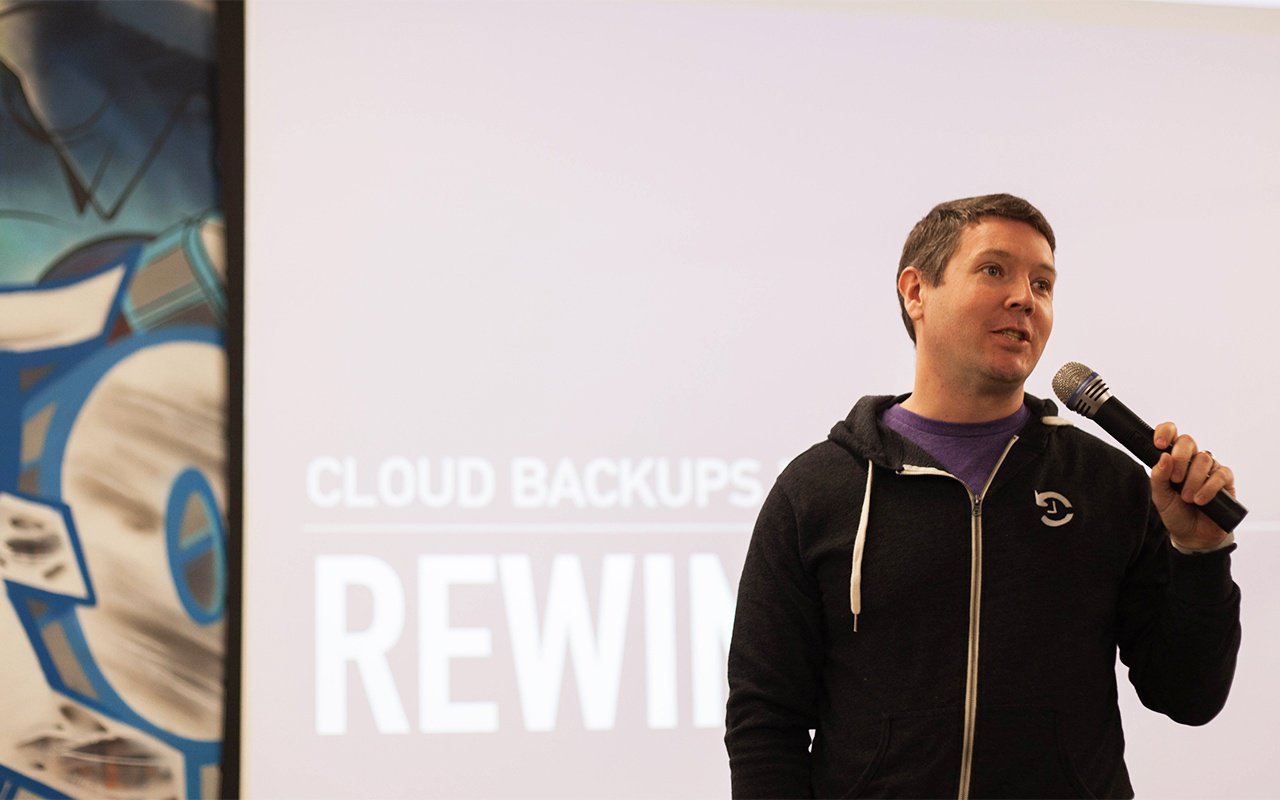I’m a data backup fanatic, with backups to my backups – and backups to those backups. But this wasn’t always the case.
While working at Adobe as a Technical Evangelist a few years ago, I was giving a presentation at a PHP conference to a few hundred developers and my boss. In the middle of my presentation, my computer suddenly and unexpectedly froze. I restarted it, but was then greeted with an icon of a hard drive with a big question mark on top.
This was known as ‘the kiss of death’ for hard drives, and immediately I realized I’d just lost everything on my computer. Needless to say, all of my hours’ worth of work on this presentation had gone to waste – and at the worst possible time.
Fast forward to Ottawa in early 2015. It was impossible not to notice Shopify’s explosive growth, so I began scouring their forums for app ideas. I soon discovered a recurring problem: many customers were asking how to backup their Shopify stores.
In some cases, they had accidentally deleted all their blog posts. In even worse cases, their entire store was lost due to some mistake.
Weren’t we all moving to the cloud to make data storage easier? So why were so many people losing critical business data?
This seemed counterintuitive. Weren’t we all moving to the cloud to make data storage easier? So why were so many people losing critical business data, and why were these cloud platforms unable to get it back?

That’s when I learned that cloud services are not always backed up in the way we think they are.
Sure, all cloud platforms have a disaster recovery backup – but there’s a big misconception around what this backup can and cannot be used for.
In reality, a disaster recovery backup is really only used to recover the entire platform all at once from a huge disaster on their end, such as a meteorite crashing into their servers.
No matter how much they would like to help you specifically, most cloud platforms cannot use their disaster recovery backup to fix problems in your individual account. This includes mistakes that you accidentally make, poorly written code from someone you hired, and/or a third-party app changing your store. It’s simply too difficult and expensive to sift their entire database of hundreds of thousands of accounts in order to recover one small part of an individual account.
Today, enterprise companies are using an average of 91 cloud services – and that’s just in the marketing department! HR, Finance, and Sales are equally dependent on cloud apps and services, as revealed by the Internet Trends report for 2017.
But they’re not alone – small businesses are also relying on cloud apps at an increasing rate. It’s clear that our dependence on cloud apps is here to stay, but if we don’t have proper backup systems in place to ensure that this data is being kept safe, more businesses will be at risk of failing.
JournalSpace: Gone Without a Backup
A business that’s taken you years to build could all be taken away in the blink of an eye, thanks to one data disaster. That’s exactly what happened to JournalSpace.
The blogging platform was once set to become a main competitor of BlogSpot and WordPress, long before Medium even arrived. JournalSpace had been growing for 6 years, until December of 2008 when a disgruntled ex-employee maliciously wiped their whole database.
Peter Graves reported that this same employee had set up a substandard backup system on a Mirror drive, but it was so poorly established that it couldn’t be used to recover the lost data from the main disc drive.
Along with all the work that had disappeared as a result, the community around JournalSpace was also lost, scattered to other blogging platforms. To many of its members, this was the biggest heartache.
For users of cloud services, this both highlights and serves as a reminder of the danger of blindly trusting that the platform will always be responsible for your backups, and that it’ll be capable of restoring your lost data when needed.
The Problem With Backups Today
Backups are time-consuming
On paper, most people know that they need to backup their data. But they expect that it’s going to take hours of manual work, they’ll need to buy external hard drives, and they’ll need to enforce a data backup routine every week. For some cloud apps like Shopify, backing up the store requires multiple steps, including manually copying your blog posts to text documents. Try telling an entrepreneur that they need to block off an entire afternoon to backup their data…
It just won’t happen.
Backups are difficult to restore
The second problem with cloud data is the difficulty in trying to restore it. Any experienced Shopify user will tell you that importing a CSV file backup into their store can be a nightmare. In the best-case scenario, it requires several hours’ worth of work – and that’s already when being done by someone with the technical know-how. For those who aren’t necessarily tech-savvy, it can take much longer.
And in the worst case scenario? The import can end up causing even more damage to the website. Not being able to easily restore a backup renders it pretty much useless.
Finding a Solution
I knew that a solution to this cloud backup problem therefore needed to have two critical components:
1. It had to be automated (set it and forget it), and
2. It needed to allow users to restore their data quickly and in real-time
In June of 2015, I partnered with James Ciesielski to build the first prototype of Rewind. Based on our beliefs, we designed Rewind to backup Shopify stores automatically, with no settings to mess with or configuration required on the customer’s part.
While building the first prototype of Rewind, the most common objection we heard was: “Why doesn’t Shopify just build this?”
One of the key components of a good backup system is having copies of your backups in different locations. That way, if anything were to happen to the disaster recovery backup, your Rewind backup is stored and managed in a completely separate environment. It’s a best practice that serves to protect the client.
Within hours of releasing Rewind into the world, we already had Shopify store owners signing up.
A few months later, the inevitable data disaster happened. Les Sharma, owner of SnuggleFeet and one of the first Rewind customers, had all of her products deleted by an inventory management app – just a few weeks before Christmas, in the middle of the busiest shopping time of the year. She contacted us in a panic.
That was our make-or-break moment. After all, it was exactly what Rewind had been created for. So we dropped what we were doing, and worked to get all her data restored.
Sure enough, we proved that we could not only backup a Shopify store, but that in a time of crisis, we could also restore it exactly to the way it was just minutes before the disaster.
Les was in awe as she refreshed her page and saw all of her products coming back to the site as if nothing had ever happened; the exact same as they were before the problem occurred… Truly a Christmas miracle!
Since then, we’ve assisted countless customers in recovering their online stores when their ecommerce platform was unable to help. Their stories can be found among the hundreds of reviews in the Shopify App Store, the BigCommerce App Store, or in interviews with customers such as Michelle Goyette and Ben Hyman.

Our Vision for Rewind
Shortly after launching Rewind for Shopify, BigCommerce approached us with the request that we build Rewind on their platform as well, since their customers were having the same issue.
Soon after that, store owners began to ask us about backing up their accounting data in QuickBooks Online and Xero. And then Trello. And GitHub. And Jira…
At that point, James and I knew we had a business, and Rewind took off.
Today, we’re a team of 100+. We are backing up billions of items for 100,000+ business owners in over 100 countries – but our mission to help protect businesses against data disasters doesn’t end there.
Our vision for Rewind is to become the only service you’ll ever need to back up all of the critical cloud apps that you use to run your business. You will never again have to manually run a backup or spend hours trying to restore it.
It’ll be a no-brainer insurance policy for your data, the same way that we think about life insurance.



